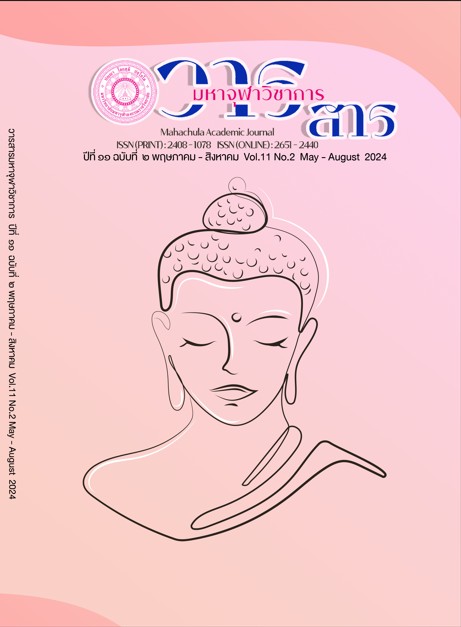The Networking of Cultural Tourism based on the Buddha’s Footprints in ASEAN Countries : A Case Study of Thailand and Lao
Main Article Content
Abstract
This research project had three objectives; 1) to study and analyze the important Buddha’s footprints in Thailand and Lao, 2) to analyze the process of the networking of cultural tourism in Thailand and Lao, and 3) to synthetize the guideline of conservation and development of the Buddha’s footprints to constructive and sustainable connect the networking of cultural tourism in Thailand and Lao. The research methodology was qualitative research with the documentary study and the field study by using observation, in-depth interview the 5 key informants of each places, and focus group discussion. The fields of the research consist of 5 areas: Thailand 4 places and Lao 1 place.
The research result was founded that; (1) The 5 important Buddha’s footprints of the field areas had been different background, importance and the development principles corresponding to the concept of networking in 3 dimensions: Management, tourist service, and supporting. And then they correspond to the concept of cultural tourism into these factors: Attraction, accessibility, amenities, accommodation, activities and ancillary service. These factors impacted to the 5 Buddha’s footprints become to be the popular cultural tourism place of local, countries and world based on the Buddha’s footprint. (2) For the process of development of networking cultural tourism in Thai and Lao, it was found that there were the internal potentiality and cooperation with the external organization. These factors impacted to continued development of the Buddha’s footprints both of buildings and contextual places to respond the needs of peoples and organization in local community and tourists both of internal and oversee countries who came to visit in each year. (3) For the guideline of conservation and development of the Buddha’s footprints to constructive and sustainable connect the networking of cultural tourism in Thailand and Lao, it was found that there were the ways of conservation and development into 5 connections: International connection, participative connection, faith connection according to the Buddha travelled around the world, archeological connection, and connection with the world heritage.
Article Details

This work is licensed under a Creative Commons Attribution-NonCommercial-NoDerivatives 4.0 International License.
References
บรรณานุกรม
๑. ภาษาไทย
จุฑารัตน์ ทองอินจันทร์. “รูปแบบการจัดการท่องเที่ยวเชิงวัฒนธรรมตามรอยพระพุทธบาทวัดพระพุทธบาท
จังหวัดสระบุรี”. วารสารมหาจุฬาวิชาการ. ปีที่ ๙ ฉบับที่ ๒. (พฤษภาคม – สิงหาคม ๒๕๖๕) : ๑๗ – ๓๓.
จิรกิตต์ภณ พิริยสุวัฒน์ และคณะ. “การสร้างเครือข่ายการท่องเที่ยวเชิงวัฒนธรรมอำเภอเชียงคาน จังหวัดเลยและ
เมืองหลวงพระบาง สาธารณรัฐประชาธิปไตยประชนลาว”. รายงานการวิจัย. สถาบันวิจัยพุทธศาสตร์ : มหาวิทยาลัยมหาจุฬาลงกรณราชวิทยาลัย, ๒๕๖๐.
จวน คงแก้ว, “พุทธศิลป์ในรอยพระพุทธบาท”, Journal of Thai Interdisciplinary Research, Vol. 11 No.4
(July – August 2016): 74.
ชูศักดิ์ วิทยาภัค, “การท่องเที่ยวกับการพัฒนา มองผ่านการท่องเที่ยวเชิงวัฒนธรรมในหลวงพระบาง สปป.ลาว”.
รายงานการวิจัย. กรุงเทพมหานคร สำนักงานกองทุนสนับสนุนการวิจัย, ๒๕๕๓.
พระศาสนโศภน. สวดมนต์แปล. กรุงเทพมหานคร: โรงพิมพ์มหามกุฏราชวิทยาลัย, ๒๕๑๙.
พระชาญชัย จนฺทสโร (บุญหล้า), พระครุศรีคัมภีรญาณ, โสวิทย์ บำรุงภักดิ์ และพระมหาสำรอง สญฺญโต.
“การศึกษาวิเคราะห์คติความเชื่อและคุณค่าของการบูชารอยพระพุทธบาทของชาวพุทธ อำเภอสหัสขันธ์ จังหวัดกาฬสินธุ์”. วารสารพัฒนาการเรียนรู้สมัยใหม่. ปีที่ ๕ ฉบับที่ ๕ (กันยายน – ตุลาคม ๒๕๖๓) : ๒๖๐ – ๒๖๙.
พระจำรัส โชติธมฺโม (พินิจกิจ). “การวิเคราะห์ความเชื่อเกี่ยวกับการบูชาพระพุทธบาทสี่รอย อำเภอแม่ริม จังหวัด
เชียงใหม่”. บทความวิจัย. วารสารพุทธศาสตร์ศึกษา มหาวิทยาลัยมหาจุฬาลงกรณราชวิทยาลัย
วิทยาเขตเชียงใหม่. ปีที่ ๑๒ ฉบับที่ ๑ (มกราคม - มิถุนายน ๒๕๖๔) : ๑๔๕ - ๑๕๘.
ลำพอง กลมกูล. “การจัดการท่องเที่ยวเชิงวัฒนธรรมและศาสนาในประเทศอาเซียน : กรณีศึกษาหลวงพระบาง
สปป.ลาว”. บทความวิจัย. ภายใต้โครงการพัฒนาการวิจัยเชิงพื้นที่ในกลุ่มประเทศอาเซียน. ศูนย์อาเซียนศึกษา : มหาวิทยาลัยมหาจุฬาลงกรณราชวิทยาลัย, ๒๕๖๑ : ๑ - ๒๕.
สุภาภรณ์ ประสงค์ทัน. "ทุนทางสังคมกับแนวทางการส่งเสริมการท่องเที่ยวโดยชุมชนเชิงสร้างสรรค์ : กรณี ศึกษา
ชาวไทยพวน อ.ปากพลี จ.นครนายก". บทความวิจัย, วารสารสังคมศาสตร์ มหาวิทยาลัยศรี
นครินทรวิโรฒ. ปีที่ ๑๖ (มกราคม-ธันวาคม ๒๕๕๖) : ๑ - ๑๑.
ห้าวหาญ ทวีเส็ง. "การพัฒนาการท่อมเที่ยวเชิงสร้างสรรค์ กรณีศึกษาศูนย์กลางเศรษฐกิจนกเทศบาลนครยะลา".
วิทยานิพนธ์หลักสูตรบริหารธุรกิจมหาบัณฑิต. สาขาการจัดการท่องเที่ยว. บัณฑิตวิทยาลัย :มหาวิทยาลัยสงขลานครินทร์, ๒๕๕๕.
อรรถกถาปปัญจสูทนี เล่มที่ ๔ (ม.อ. ปปญฺจ ๔/๓๙๕ - ๓๙๗), อรรถกถาปุณโณวาทสูตร, อรรถกถามัชฌิมนิกาย
อุปริปัณณาสก์ สฬายนวรรค, พระไตรปิฎกภาษาไทย ฉบับมหาจุฬาลงกรณราชวิทยาลัย เล่มที่ ๑๐ หน้าที่ ๓๙๕ – ๓๙๗.
๑. ภาษาอังกฤษ :
A S Hornby. Oxford Advanced Learner’s Dictionary of Current English. Seventh edition,
London: Oxford University Press, 2005.
Duxbury Nancy and team. “Creative Tourism Development Models towards Sustainable and
Regenerative Tourism, Sustainability”. 2021, pp. 2, 13 [Online], Available: https://dx.doi.org/10.3390//su13010002 [6 May, 2023].
Markus Aksland. the Sacred footprint: A cultural History of Adam’s Peak. first published,
Bangkok: Orchid Press, 2001.
Mrs. Jutarat Tonginjan. “A Critical Study of Buddhist Principles from the Buddha’s Footprints”,
Dissertation of Doctor of Philosophy in Buddhist Studies. Graduate School:
MahachulalongkornRajavidyalaya University, 2018.
S. Sirikudta & P, Archarungroj & Sirisuthikul, Varintra. “Sustainable Creative Tourism for Fulfilling
the Gap between Tourists’ Expectation and Perception towards Tourism Routes in the Upper Greater Mekong Sub region”. International Journal of Humanities, Arts and Social Sciences, 5 (2019), pp.43-53.
“ความเชื่อ ตำนานเรื่องรอยพระพุทธบาททั้ง ๕ แห่ง ตามพระไตรปิฎกและความเชื่อต่าง ๆ”, แหล่งข้อมูล
[ออนไลน์] https://www. faiththaistory.com [เข้าถึงข้อมูล ๑๕ ตุลาคม ๒๕๖๖].
“จำนวนรอยพระพุทธบาทในประเทศและต่างประเทศ”, แหล่งที่มา [ออนไลน์]. http://tamroiphrabuddhabat.com/xmb/viewthread.php?tid=96 [เข้าถึงข้อมูล ๘ ตุลาคม ๒๕๖๖].


